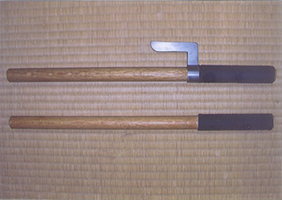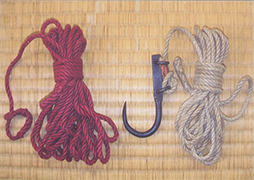Edo machikata jutte torinawa atsukai yō was established as part of the 8th Tokugawa shogun Tokugawa Yoshimune's (1684– 1751) Kyōhō reforms by Kamei Magoroku Shigemura (n.d.), a retainer of the Mikawa Yoshida domain in today's Aichi prefecture, and fourth headmaster of Yagyūryū truncheon techniques. On government orders, Shigemura surveyed more than 30 traditional styles of truncheon techniques transmitted in various domains, and synthesized their strong points to establish and codify Edo machikata jutte torinawa atsukai yō. The appellation "arresting methods" (atsukai yō) rather than "technical style" (jutsu) is used in order to differentiate this new system from the traditional schools of truncheon techniques from which it is derived. Edo machikata jutte torinawa atsukai yō was used to arrest and restrain suspects by the police force of Edo, today's Tokyo.
Edo machikata jutte torinawa atsukai yō consists of the following sets of techniques: An opening form known as "shattering falsehood and revealing truth" (hanja kensei), basic stances (six forms), truncheon techniques (12 forms), binding techniques (12 forms), double truncheon techniques ("pair of horns" sōkaku; 18 forms), as well as inner techniques. In double truncheon techniques the main truncheon is carried in the left and used together in a two-handed fashion with a naeshi, or jutte without capturing hook, carried in the right.
As the aim of Edo machikata jutte torinawa atsukai yō is to arrest and restrain suspects and criminals, its techniques differ from those of other martial arts in that they do not contain a shime or finishing move.
The truncheons used in Masakiryū are about 48 cm long, and the binding rope is circa four meters long.

jutte for practice Click to enlarge

jutte for practice

left:binding rope right:hook rope
Click to enlarge

left:binding rope right:hook rope

